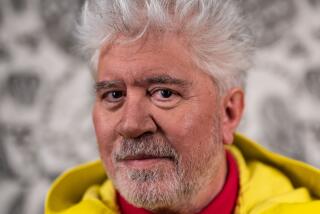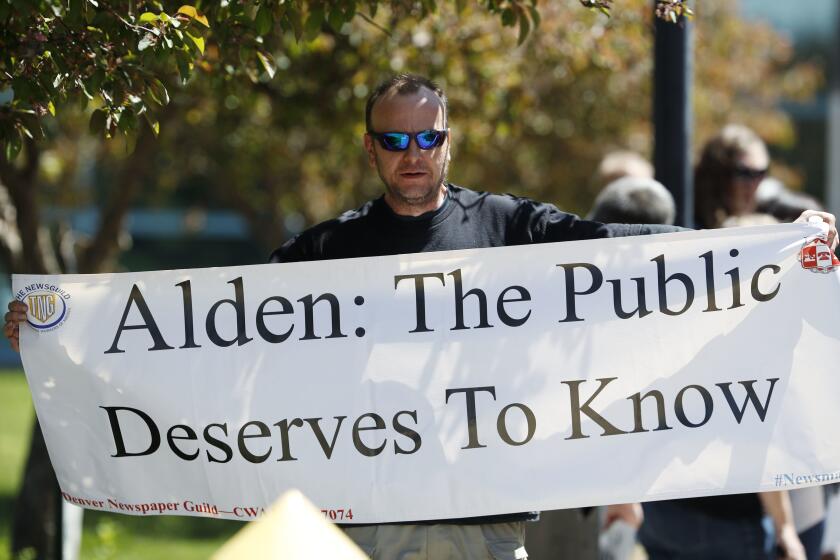Review: Love’s variations in Joan Wickersham’s ‘The News From Spain’
The News From Spain
Seven Variations on a Love Story
Joan Wickersham
Alfred A. Knopf: 208 pp., $24.95
It’s difficult to read Joan Wickersham’s “The News From Spain: Seven Variations on a Love Story” without thinking about Margaret Atwood’s short story “Happy Endings.” There, Atwood traces seven variants of affection, focusing on a couple named John and Mary, for whom “[t]he only authentic ending is the one provided here: … John and Mary die. John and Mary die. John and Mary die.”
The point is that “endings are the same however you slice it,” which Wickersham understands as well. That’s why she builds the seven loosely related pieces of fiction here around the amorphous middle, which is ultimately the only thing that life, or narrative, has to offer us.
This is not the first time Wickersham has written a book around a formal conceit; her last effort, the National Book Award-nominated “The Suicide Index,” examined her father’s suicide by framing it in the form of an index, complete with alphabetical subject heads. It’s a bravura performance, not least because, even as she is developing it, Wickersham has to admit the futility of the construction: “Up until now,” she admits, “I’ve pretty much been sticking to a standard linear way of telling the story of my father’s suicide. I’ve adhered to chronology: first this happened, then that happened. … I’m not going to be able to keep it up.” Such a tension, between order and chaos, between what we can know and what we can never know, gives the work a vivid open-endedness, a sense of life as it is lived.
“The News From Spain” aspires to a similar sort of interplay, this time involving the possibilities and disappointments of love.
“You meet someone, you fall in love, you marry,” Wickersham observes in the closing pages. “You meet someone, you fall in love, it turns into a disaster. You meet someone, you fall in love, but one of you is married, or both are: you have or don’t have an affair. You meet someone, you fall in love, but you are never quite sure if your feelings are returned.”
Here, in just a few sentences, Wickersham summarizes the collection’s conflicts, making this a coda of a kind. At the same time, it is more and less than that.
What links these seven stories, after all, is nothing so simple as character or situation; they are connected by theme. The love they evoke could be damaged, as in the first story, where a married couple, trying to recover from the husband’s infidelity, goes to a summer engagement party. It could be filial, as in the second story, where a bookseller named Rebecca finds purpose in caring for her mother, Harriet, or even lost, as in the magnificent central story, about a paralyzed former dancer whose husband is on tour with his dance troupe, including the younger dancer with whom he has taken up.
“Biographers, early in the next century, forty years from now, will write about this little room,” Wickersham notes of the den in which the dancer’s husband sleeps, “speculating on whether he was sleeping there before she got sick, suggesting that the marriage was already in trouble, that they were on the brink of separating, that he stayed on after her illness out of a sense of duty and guilt — but he and she will both be dead by the time these rumors become public.”
For Wickersham, this is an essential passage, revealing the way time, mortality, changes our stories, particularly our love stories, in ways we cannot know. What distinguishes the book’s best narratives is their openness, their sense that anything can happen, that life always surprises us, even when we expect it will. “A love story — your own or anyone else’s — is interior, hidden,” Wickersham warns. “It can never be accurately reported, only imagined, it is all dreams and invention. It’s guesswork.”
That’s a gutsy thing to acknowledge in a book that is itself an expression of guesswork, a series of roads both taken and not. “Already Rebecca can tell the story two ways,” Wickersham writes about the start of a relationship, and the same is true of the collection as a whole. And yet, what anchors the best parts of “The News From Spain” is their inevitability, the idea that out of all the possibilities, there is no other way to go.
When the dancer bonds with her caregiver Malcolm — the closing scene of this story, shared between them, is so moving it will close your throat — we know their connection for what it is: the only thing keeping both of them rooted in the world. The same is true of Rebecca and her mother, with their back-and-forths, their mutual dependence, or of the narrator of the final story, a 60-year-old woman telling stories to keep her desire at bay.
Unfortunately, that’s not true of all the narratives; others feel, to varying degrees, contrived, a series of stunts that show their seams. Still, that’s the danger of building a book around a concept: Sometimes the construct overwhelms the material.
Ultimately, the work that lingers may be that which speaks most directly to Wickersham’s own circumstance. In “The Suicide Index,” she describes her marital issues, as well as her relationship with her mother, who ends up in an assisted living facility because of paralysis.
This is not to say that fiction need be autobiographical — nor even that the pieces in “The News From Spain” should be read that way. But when Wickersham writes, as she does in the final story, that “[s]ome of this is fiction and some isn’t,” it opens up another set of layers in which the final variation, perhaps, is a variation on life.
More to Read
The biggest entertainment stories
Get our big stories about Hollywood, film, television, music, arts, culture and more right in your inbox as soon as they publish.
You may occasionally receive promotional content from the Los Angeles Times.











